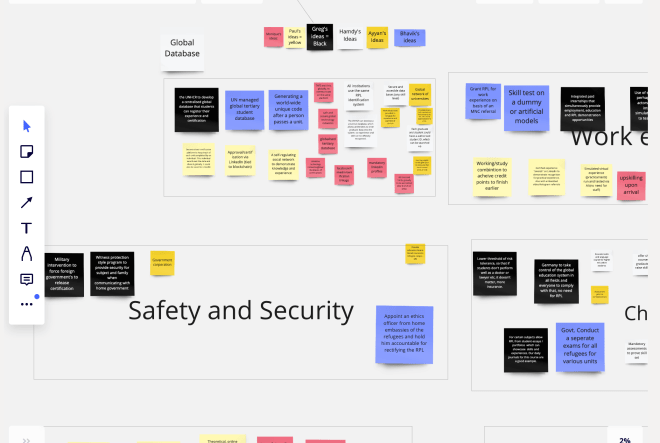The 7th session was focused on the 3rd phase of the Stanford design school design thinking process, which was the ideation phase. This is where we come up with creative solutions to solve the problems that we looked at in the emapthise and define phases. Brown (2009) postulated that design thinking involves moving between four mental state, including convergent and divergent thinking and analysis and synthesis.
In the early parts of our ideation, we a had a pretty wild and free brainstorming session, keeping it in my mind in the realms of divergent thinking. This is basically when you are brainstorming, and you write down any idea no matter how crazy. Brown in fact suggests that brainstorming is one of the key ingredients for brainstorming along with optimistic and experimental attitudes, some tolerance of risk and a flair for visual thinking.
We had a little practice in class, you might like to do this too. Basically, grab some paper, draw a bunch of circles on it and spend a couple of minutes transforming as many as you can into something recognisable. See you can draw. Here some of mind below. This little exercise was adapted by Gayle Curtis (2009). This exercise also allows us to throw away the notion that things need to be perfect in order to be functional for ideation purposes. They do not.
To remind you briefly of our problem it was to get more refugees into higher education, and we concluded from some of our earlier research that some of what was holding refugees back was the lack of recognition for prior learning (RPL). One of the reasons for this was that the refugees home governments couldn’t or wouldn’t share the information with foreign universities, or the students, fearing for their safety were reluctant to reach back to their home country.
So one of the wildest ideas from yours truly was that we should invade all of those nasty country and occupy them and make them do the right thing. You are probably not surprised to hear that when we moved into the convergent phase of our ideation (Which is an excellent method for deciding between alternative solutions) the invasion idea was quickly discounted.
Something else that was interesting in session 7 the idea of creating “How might we?….” statements. For example: “How might we help refugees access documentation from their home university to allow them to access RPL.” This immediately resonated with me as a Business Analyst. In Scrum (Schwaber & Beedle 2001) we have user stories, that are effectively broken-down bits of a larger problem and to riff of the previous example sound a bit like this “As a refugee I want to be able to access the documentation from my home university so that I can apply for RPL in my host country” Sometimes hundreds of these stories will go into making a functional piece of software. We developed 10 of these individually which is what led to the invasion idea mentioned above. Here an excerpt of all this ideation below, as you can see, we worked together to theme and group them, the other interesting technique in this session was the napkin pitch from Liedtke & Ogilvie (2014).

This was a great session and as I am now working back in the software development industry, I will certainly use a number of these ideation techniques to work with my team to come up with creative, unexpected and hopefully delightful solutions to solve the needs of our customers.